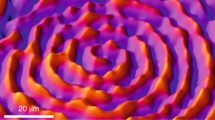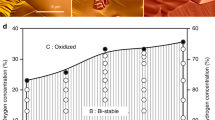Abstract
THE rates of chemical reactions may exhibit temporal oscillations, even when the reaction parameters are kept constant. These oscillations might be associated with spatial pattern formation owing to local variations of concentrations or temperature, or both, which propagate as chemical waves1,2. An example is the catalytic oxidation of carbon monoxide on the surfaces of platinum single crystals. The mechanism of this reaction is well known, and under isothermal, low-pressure conditions, many types of temporal self-organization, ranging from harmonic oscillations to chaotic behaviour, have been observed3–6. Spatial patterns have also been demonstrated by scanning beams of either electrons3 or ultraviolet photons6 across the surface, and by monitoring the electrons reflected or photoemitted, respectively. However, both scanning techniques are hampered by limited temporal as well as lateral resolution. Here we present observations of an unexpectedly rich variety of self-sustained spatio-temporal patterns by continuous imaging (on a timescale of ≳1 ms) of the surfaces using a newly developed, photoemission electron microscope7 with a spatial resolution of a few micrometres. Pattern evolution can be followed on a much finer timescale than is available from other imaging techniques. We observe a new type of structure with strong similarities to those found in the Belousov–Zhabotinsky oscillatory reaction.
This is a preview of subscription content, access via your institution
Access options
Subscribe to this journal
Receive 51 print issues and online access
$199.00 per year
only $3.90 per issue
Buy this article
- Purchase on Springer Link
- Instant access to full article PDF
Prices may be subject to local taxes which are calculated during checkout
Similar content being viewed by others
References
Nicolis, G. & Baras, F. (eds) Chemical Instabilities (Reidel, Dordrecht, 1984).
Field, R. J. & Burger, M. (eds) Oscillations and Travelling Waves in Chemical Systems (Wiley, New York, 1985).
Imbihl, R., Cox, M. P. & Ertl, G. J. chem. Phys. 84, 3519–3534 (1986).
Eiswirth, M., Krischer, K. & Ertl, G. Surf. Sci. 202, 565–591 (1988).
Eiswirth, M., Möller, P., Wetzl, K., Imbihl, R. & Ertl, G. J. chem. Phys. 90, 510–521 (1989).
Rotermund, H. H., Jakubith, S., Von Oertzen, A. & Ertl, G. J. chem. Phys. 91, 4942–4948 (1989).
Kordesch, M. E., Engel, W., Lapeyre, G. J., Zeitler, E. & Bradshaw, A. M. Appl. Phys. A49, 399–402 (1989).
Griffith, O. H. & Rempfer, F. F. Adv. opt. Electron Microsc. 10, 269–337 (1987).
Winfree, A. T. in Oscillations and Travelling Waves in Chemical Systems (eds Field, R. J. & Burger, M.) 441–472 (Wiley, New York, 1985).
Noszticius, Z., Horsthemke, W., McCormick, W. D., Swinney, H. L. & Tam, W. Y. Nature 329, 619–620 (1987).
Author information
Authors and Affiliations
Rights and permissions
About this article
Cite this article
Rotermund, H., Engel, W., Kordesch, M. et al. Imaging of spatio-temporal pattern evolution during carbon monoxide oxidation on platinum. Nature 343, 355–357 (1990). https://doi.org/10.1038/343355a0
Received:
Accepted:
Issue Date:
DOI: https://doi.org/10.1038/343355a0
This article is cited by
-
Identifying and avoiding dead ends in the characterization of heterogeneous catalysts at the gas–solid interface
Nature Catalysis (2023)
-
Visualizing catalyst heterogeneity by a multifrequential oscillating reaction
Nature Communications (2018)
-
Electromechanical vortex filaments during cardiac fibrillation
Nature (2018)
-
Heterogeneous Surfaces as Structure and Particle Size Libraries of Model Catalysts
Catalysis Letters (2018)
-
Switchable CO2 electroreduction via engineering active phases of Pd nanoparticles
Nano Research (2017)
Comments
By submitting a comment you agree to abide by our Terms and Community Guidelines. If you find something abusive or that does not comply with our terms or guidelines please flag it as inappropriate.



